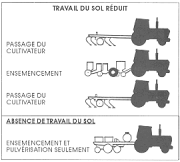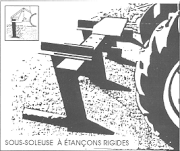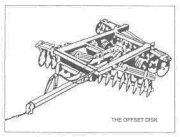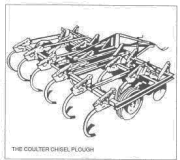Over 70% of New Brunswick's agricultural land has physical limitations due to compacted subsoil and poor structure (45.5%); steep topography (20.8%) and shallowness to bedrock (5.8%). In order for this land to achieve its productive potential, a proper level of management inputs is required. In addition to these inherent problems associated with the land base, erosion by water has become the main concern in the potato producing areas of the St. John River Valley. The major factors that have increased the risk of soil degradation are:
Conservation Tillage
- Monoculture or indifferent crop rotation with minimum use of cover crops.
- The use of heavy equipment on wet land.
- Exessive stone removal.
- Up and down the hill farming on steep topography.
- Excessive, untimely and the use of unsuited tillage equipment.
- Minimum use of barnyard and green manures.

Our goal is now, therefore, to reduce soil erosion and keep water in the soil while improving overall crop production and productivity.
Conservation tillage offers an opportunity towards achieving this goal without imposing too many changes to our production systems.
Concerns over excessive soil erosion necessitate increased efforts at maintaining crop residues on the soil surface through conservation tillage.

What is Conventional Tillage?
Conventional tillage is a full tillage program combining primary and secondary tillage operations performed in preparing a seedbed for a given crop and area. Primary tillage is performed in the fall (or spring) with a mouldboard plow followed in the spring by secondary tillage (disking (twice) or disking and the use of a vibrashank or soil finisher or rotovator or spring tooth and spike tooth harrows). The system performs as indicated below:
- Inverts the soil to form furrows.
- Buries crop residues so that there is slow decay and no surface mulch effect.
- Exposes bare soil to water and wind erosion. May compact the soil beneath the plow.
- Minimal ridging effect.
- High cost per acre.
- Power requirement of 15 h.p. per plow bottom.
- Ideal for sod ground.
What is Conventional Tillage?
Conservation tillage is any tillage system that reduces the number of passes over the field for land preparation and increases the surface residues to protect soil and water loss. The system includes single disking, chiselling, subsoiling, ridging and no-till. No-till, however, has not, up to this time, proven a viable alternative in New Brunswick,

Equipment Frequently Associated With Conservation Tillage:
The Subsoiler:
This consists of rigid steel shanks which do not invert the soil.
- Pre-tillage operation.
- Breaks up compacted layers 16"(40 cm) or more below soil surface.
- Allows deep percolation of water.
- Allows deeper root penetration.
- Requires 30 h.p. per shank. Ideal where drainage tiles have been installed.
- Must be done when the subsoil is dry.
- A rigid Shank.
Diesel fuel requirements: - Subsoiler - 2.1 gal/ac for loams (23.581/ha)
- - 2.84 gal/ac for clays. (31.89 I/ha)

The Offset Disk:
This implement consists of large concave disks mounted in two rows opposing each other. The gongs cut and throw the soil in opposite directions.
- Primary tillage operation.
- Breaks up soil to 8-10" (20-25 cm).
- Shallow incorporation of residues for rapid decay.
- Good surface mulch effect for erosion reduction,
- Low cost per acre.
- 12-14 h.p. needed per foot width.
Diesel fuel requirements: - 0.95 gal/ac for loams (10.67 I/ha)
- 1.28 gal/ac for clays (14.37 I/ha)

The Chisel Plow
This implement consists of multiple rows of staggered curved shanks mounted rigidly, with spring cushions, or with spring resets.
- Primary tillage operation.
- Breaks up soil to 8-10" (20-25 cm).
- Shallow 'incorporation of residues for rapid decay.
- Good surface mulch effect for erosion reduction.
- Low cost per acre.
- Good ridging effect.
- Minimal compaction.
- Operating speed 5 mph or higher,
- Requires 15 h.p. per shank
Diesel fuel requirements: - - .1.25 gal/ac for loams (14.04 I/ha)
- - 1.69 gal/ac for clays (18.98 I/ha)

The Coulter Chisel Plow
This implement consists of chis~el plows with gangs of flat or concave disks preceding the shanks to cut surface residues and vegetation.
- Primary tillage operation.
- Breaks up soil to 8-10 in, (20-25 cm).
- Shallow residue incorporation.
- Good surface mulch effect for erosion reduction.
- Good ridging effect.
- Minimal compaction.
- Low cost/acre.
- Requires 15 h.p. per shank.
- Operating speed 5 mph The Coulter Chisel Plow or higher.
Diesel fuel requirements: - - 1.30 gal/ac for loams (14.60 I/ha)
- - 1.70 gal/ac for clays (19.09 1/ha)
